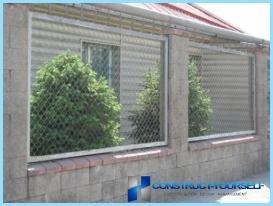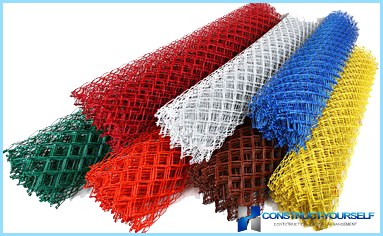The contents
Mesh Netting is named in honor of the inventor, which has given the construction material for the construction of fences and barriers. In 1878 it was first described by the inventor. There is another view – the first mention of the mesh Netting in the patent is dated 1872, and the document was issued in the name of John. Peters. There are two types – rhombic and square. Netting sold in rolls. Mostly has the standard options is 10 m long and 1.5 m wide. It can be made according to the parameters specified by the customer.
How to produce the Rabitz ↑
The mesh is produced by special machine. Used for the manufacture of wire of steel, it can be galvanized or coated with polymer. On the machine is screwing wires into each other with a flat coil. The manufacturing process – simple.
Applications:
- Used to mount the fences around the infield, cottage, garden;
- Mesh Netting material for the manufacture of cages and enclosures for animals;
- With it you can sift materials.
Properties:
- Vary product is the diameter of the wire from which made. The thicker the wire, the better and durable mesh. High quality indicators is different wire for mesh parameters 35х35х2,5 mm 50x50x3 mm. Railings made of this material will last longer, can be used in any conditions.
- Characteristics is the size and shape of the cell. Noteworthy is the size of the cells is affect the level of mesh density. Dense, monolithic more costly transmits less light. Cell sizes depend on the purpose for which it will be used:
- 25 – 40 mm – sufficient small mesh, such mesh is suitable for fencing and for the construction of the enclosure;
- 40 – 50mm is the best option for constructing the fence, is the average size of the cells;
- Up to 60 mm – the largest cell.
Treatment:
- Galvanized. Great importance is the amount of zinc, which is applied to the surface – is measured in grams/square meter. The more zinc is applied, the longer the fence. The optimal number is 80-90 g/sq. m. Produced mesh Netting with less zinc coating. What is dangerous zinc deficiency in? Since the product of metal, it is prone to corrosion – if the fence is not sufficiently protected by zinc coating, it may rust after a few months.
- Ungalvanized. It is not recommended to use for the installation of fencing, such as mesh will quickly begin to rust under the influence of moisture.
- Mesh with PVC-coated or powder-coated. Polyvinylchlorid or PVC – the perfect coating for mesh that protects against corrosion and provides an attractive appearance. The polymer coating provides resistance during a hard frost. Mesh with PVC coating does not fade in the sun.
What are the advantages of mesh ↑
- Territory is fenced by a fence, will be clearly visible.
- The fence mesh Netting provides ventilation areas.
- The mesh Netting is the most affordable material which allows you to build a fence around the infield.
- Mounting the fence even for a layman.
- This fence is reliable and durable.
- Mesh Netting, especially with PVC coating, aesthetic material for fencing.
- It is possible to make not only the fence, but the gate.
What you’ll need for the installation of the fence mesh Netting ↑
- Metal pole and plug for it. It is recommended to choose a corner with a cross section of 60×40. Intermediate posts can be less massive – 40×40.
- Fittings.
- Welding.
- Mesh Netting: galvanized or PVC-coated.
- Gate and gate.
- Screws or bolts.
- Rivets threaded.

What determines the price Rabitz ↑
- The material from which it is made.
- The cell parameters.
- Wire thickness.
- Method of fastening wire.
Modification of fences made of mesh Netting shown in the photo:




To mount the fence Netting in two ways:
- Fragments of the mesh are fixed in the sections of the corner: this method is aesthetic, practical, but complicated and expensive. Costs requires metal area. The result is durable, beautiful sectional fence.
- Mesh is stretched between two adjacent pillars. With the help of this method, created the majority of fences made from this material. The method is simple and economical. The result – the fence is robust, but not durable and aesthetic.
Two ways have in common is the post to which is attached a Netting:
- Metal – most frequently used in the mounting of fences made of mesh Netting. Advantages: durability, reliability longevity. As intermediate posts use a metal profile. Acceptable cross-sectional diameter of 6 – 12cm, minimum 2 cm. On the market of building materials presents special posts to mount the fence of mesh Netting – they have hooks for attaching.
- Of wood. The material is available, but unreliable and short-lived. Recommended for temporary fences. Sometimes, the choice of the tree stops if it is much cheaper than metal.
To wood all fastened with nails or clamps.
- Concrete is rarely used to mount fence netting because of fencing the massive concrete supports simply do not need. They can be fastened to the mesh with a clamp or tether.
- The first stage is the layout. Trying to drive pegs for pegging, and between them pulled the cord. By measuring the length of the thread will know the length of the mesh.
Mark the points for the emplacement of pillars. The standard step is not more than 2.5 metres. If the step is 2.5 meters or more, the mesh can SAG.
What to do?
- Set again on 20 posts all at the same distance, except the last one – the distance between them is less than.
- You can install 20 pieces of equal distance, which must not exceed 2.5 metres. In this case, by dividing 49 by 20 – out 2.4 m.
So, in any case, when the distance of 49 metres we need 20 of profile pipes!
Marked for dropping are doing, pulling the thread to the poles was dug on a flat line.

- Mounting pillars. Holes you can dig with a shovel by hand. If the soil is hard, use a drill. The most important columns – corner, they dig in in the first place. The depth of the wells is 80 to 120 cm In the hole set the post, poured gravel or gravel, then a layer of sand. The sand must be compacted. Around the hole to pour the cement mortar.
Further action is only possible in a week – after full curing of the cement.
- Now weld a special hook-holders – they will be attached to the mesh Netting. Starting from the first corner post. Through the extreme cells threaded rod for fastening design. Further, unwinding the mesh, gradually put it on the hooks of each post and fasten the reinforcing rod. The rod allows you to pull the mesh evenly.
- Now you need to make additional support for the fence. To do this, at a distance of 15-20 cm from the top edge need to thread the rod into the grid horizontally and weld. For reliability it is recommended to weld 4 or 5 such rods. This will give rigidity to the fence.
- Need bend hooksand, if necessary, to paint the fence.












